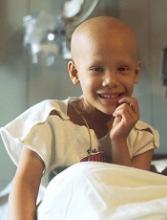Survivors of childhood Hodgkin lymphoma (HL) have a 14-fold higher risk of second cancers compared to the general population, according to new research.
The subsequent malignant neoplasms (SMNs) observed in HL survivors tended to follow specific patterns depending on the patient’s age at treatment, sex, treatment modality, and region of the body treated.
And although the risk of SMNs appears to be somewhat lower for HL patients treated in more recent decades, it is still significantly higher than the risk in the general population, according to investigators.
Anna S. Holmqvist, MD, PhD, of the University of Lund in Sweden, and her colleagues conducted this research and reported the results in Cancer.
The investigators looked at data from the Late Effects Study Group, a multinational cohort of patients age 16 or younger who were treated for HL and other cancers from 1955 through 1986.
The current report is the third update from an expanded cohort including data on 1,136 patients with a median follow-up of 26.6 years. The median patient age at diagnosis was 11 years (range, birth to 16 years), and the patients were followed for 23,212 person-years after HL diagnosis.
In all, 162 patients developed 196 SMNs, including breast cancer (n=54), basal cell carcinoma (n=34), thyroid cancer (n=30), colorectal cancer (n=15), lung cancer (n=11), and other malignancies (n=40). The disease site was not available in 12 cases.
The cumulative incidence of any SMN 40 years after HL diagnosis was 26.4%. By age 50, the cumulative incidence of any SMN was 27.2%.
The standardized incidence ratio for the entire cohort was 14.0, compared with the general population as derived from the Surveillance, Epidemiology and End Results database.
Risk factors by cancer type
Females treated with chest radiotherapy between the ages of 10 and 16 who did not receive alkylating agents or received low doses of alkylating agents had the highest risk of developing breast cancer. The cumulative incidence of breast cancer by age 50 was 45.3% in these patients.
The patients with the highest risk for subsequent lung cancer were males treated with chest radiotherapy before age 10. The cumulative incidence of lung cancer by age 50 was 4.2% in these patients.
Patients with the highest risk for colorectal cancer had received abdominal/pelvic radiotherapy and high-dose alkylating agents. The cumulative incidence of colorectal cancer by age 50 was 9.5% in these patients.
Patients with the highest risk for thyroid cancers were females who had been treated with radiotherapy to the neck before the age of 10. The cumulative incidence of thyroid cancer by age 50 was 17.3% in these patients.
The investigators noted that HL patients treated more recently are likely to have received lower doses and volumes of radiotherapy compared to patients treated in the 1950s, ’60s and ’70s.
“However, for the cohort of patients treated between 1955 and 1986, it is clear that continued surveillance for SMNs is essential because their risk continues to increase as these survivors enter their fourth and subsequent decades of life,” the investigators wrote.
They did not report a funding source for this research or make any conflict-of-interest disclosures.


